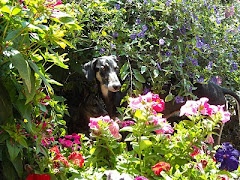There's a fascinating article in the August 15th New Yorker, "Sleeping with the Enemy," by Elizabeth Kolbert, about recent DNA evidence that indicates that early humans mated with Neanderthals (before (likely) wiping them out). Even more interesting, there is also DNA strains from yet another hominid in some of our own DNA which means there were likely several strains of humanoids that we encountered and mated with (then wiped them out?) in existence on earth before the triumphant survival of modern man.
Svante Paabo is heading up the Max Planck Institute of Evolutionary Antropology in Leipzig and is doing the DNA research and as more bone fragments come under study, it's likely that there may turn out to be even more branches of the human tree that still remain in our mitochondrial DNA. Notes the story, "Neanderthals were very closely related to modern humans -- so closely that we shared ur prehistoric beds with them -- and yet clearly they were not humans. Somewhere among the genetic disparities must lie the mutation or, more probbly, mutations that define us. Paabo already has a team scanning the two genomes, drawing up lists of likely candidates.
"I want to now what changed in fully modern humans, compared with Neanderthals, that made a difference." he said. " What made it possible for us to build up these enormous societies and spread around the globe, and develop the technology that I think no one can doubt is unique to humans. There has to be a genetic basis for that, and it is hiding somewhere in these lists."
What makes Paabo's work so important is this: "Over the decades, many theories had been offered to explain what caused the demise of the Neanderthals, ranging from climate change to simple bad luck. In recent years, though, it's become increasingly clear that, as Paabo puts it to me, "their bad luck was us." Again and again, the archeologoical evidence in Europe indicates, once modern humans showed up in a region where Neanderthals were living, the Neanderthals in that region were actively pursued, or perhaps they were just outcompeted. The Neanderthals' "bad luck" is presumbly the same misfortune that the hobbits [small hominids-- Homo floreniensis -- discovered in 2004) and the Denisovans [another extinct branch of the humanoid tree] encountered, and similar to the tragedy suffered by the giant marsupials that once browsed Australia, and the varied megafauna that used to inhabit North America, and the moas that lived in New Zealand. At it is precisely the same bad luck that has brought so many species -- including every one of the great apes -- to the edge of oblivion today.
"To me, the mystery is not the extinction of the Neanderthals," Jean-Jacques Hublin, the director of the Institute for Evolutionary Antrhropology's department of human evolution, told me. "To me the mystery is what makes modern humans such a successful group that they have been replacing not just the Neanderthals but everything. We don't have much evidence tht the Neanderthals or other archaic umans ever led to an extinction of a species of mammal or anything else. For modern humans, there are hundreds of examples, and we do it very well."
Their bad luck was . . . us. If you think about the future of this globe, that's got to be one bone chilling sentence.
The author concludes with a visit to one of the prehistoric caves at Grotte des Combarelles to view the extraordinary cave paintings. "In very recent times, the floor of the Grotte des Combarelles has been dug out, so that a person can walk in it, and the tunel is dimly lit by electric lights. But when the etchings were originally created, some twelve or thirteen thousand years ago, the only way to gain access to the site would have been to crawl, and the only way to see in the absolute dark would have been to carry fire. As I crept along through the gloom, past engravings of wisent and aurochs and woolly rhinos, it occurred to me that I really had no clue what would drive someone to wriggle through a pitch-black tunnel to cover the walls with images that only another, similarly driven soul would see. Yet it also struck me that so much of what is distinctively human was here on display -- creativity, daring, "madness." And then there were the animals pictured on the walls -- the aurochs and mammoths and rhinos. These were the beasts that Paleolithic Europeans had hunted, and then, one by one, as with the Neanderthals, obliterated."
Monday, August 22, 2011
Subscribe to:
Post Comments (Atom)












3 comments:
We're pretty scary and getting more so as discoveries are made. Would we be the first species to destroy itself? Species suicide? (There are still lemmings, right?)
Very well could be. Mother Nature moves towards balance/stasis/equalibrium. Push her too far in one direction she swings back just as severely, and if humans get in the way of the swing, bye-bye.
There is still some of the self depreciating smugness in the lesson, “The Story of the Noble Savage” do we really know what the Neanderthals did? Every creature alters it’s environment. As a species /race they were likely outcompeted by the Cro-Magnon or sapiens sapiens. Do we really know what happened? As far as I know they left behind little in cultural artifacts and the elegant tools and as best I remember the cave drawings were not made by Neanderthal hands. That we currently have outstripped Gaia’s resources and recovery potential, should not be disputable. But that has little to do with the initial impact of small bands of modified apes, capable of imaginational symbolism, inter breading or otherwise.
Post a Comment